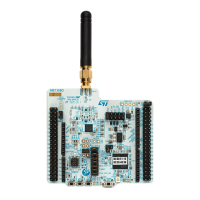Universal synchronous/asynchronous receiver transmitter (USART/UART) RM0453
1158/1450 RM0453 Rev 5
RS232 RTS and CTS flow control can be enabled independently by writing the RTSE and
CTSE bits to ‘1’ in the USART_CR3 register.
RS232 RTS flow control
If the RTS flow control is enabled (RTSE = 1), then RTS is deasserted (tied low) as long as
the USART receiver is ready to receive a new data. When the receive register is full, RTS is
asserted, indicating that the transmission is expected to stop at the end of the current frame.
Figure 329 shows an example of communication with RTS flow control enabled.
Figure 329. RS232 RTS flow control
Note: When FIFO mode is enabled, RTS is asserted only when RXFIFO is full.
RS232 CTS flow control
If the CTS flow control is enabled (CTSE = 1), then the transmitter checks the CTS input
before transmitting the next frame. If CTS is deasserted (tied low), then the next data is
transmitted (assuming that data is to be transmitted, in other words, if TXE/TXFE = 0), else
the transmission does not occur. When CTS is asserted during a transmission, the current
transmission is completed before the transmitter stops.
When CTSE = 1, the CTSIF status bit is automatically set by hardware as soon as the CTS
input toggles. It indicates when the receiver becomes ready or not ready for communication.
An interrupt is generated if the CTSIE bit in the USART_CR3 register is set. Figure 330
shows an example of communication with CTS flow control enabled.
MSv68794V1
Start
bit
Start
bit
Stop
bit
Idle
Stop
bit
RX
RTS
Data 1 read
Data 2 can now be transmitted
RXNE
RXNE
Data 1 Data 2

